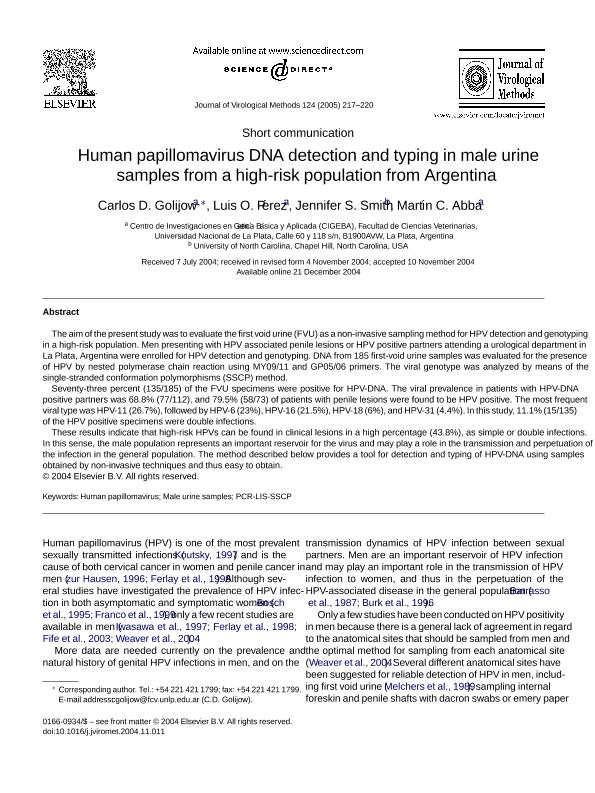Artículo
Human papillomavirus DNA detection and typing in male urine samples from a high-risk population from Argentina
Fecha de publicación:
03/2005
Editorial:
Elsevier Science
Revista:
Journal of Virological Methods
ISSN:
0166-0934
Idioma:
Inglés
Tipo de recurso:
Artículo publicado
Clasificación temática:
Resumen
The aim of the present study was to evaluate the first void urine (FVU) as a non-invasive sampling method for HPV detection and genotyping in a high-risk population. Men presenting with HPV associated penile lesions or HPV positive partners attending a urological department in La Plata, Argentina were enrolled for HPV detection and genotyping. DNA from 185 first-void urine samples was evaluated for the presence of HPV by nested polymerase chain reaction using MY09/11 and GP05/06 primers. The viral genotype was analyzed by means of the single-stranded conformation polymorphisms (SSCP) method. Seventy-three percent (135/185) of the FVU specimens were positive for HPV-DNA. The viral prevalence in patients with HPV-DNA positive partners was 68.8% (77/112), and 79.5% (58/73) of patients with penile lesions were found to be HPV positive. The most frequent viral type was HPV-11 (26.7%), followed by HPV-6 (23%), HPV-16 (21.5%), HPV-18 (6%), and HPV-31 (4.4%). In this study, 11.1% (15/135) of the HPV positive specimens were double infections. These results indicate that high-risk HPVs can be found in clinical lesions in a high percentage (43.8%), as simple or double infections. In this sense, the male population represents an important reservoir for the virus and may play a role in the transmission and perpetuation of the infection in the general population. The method described below provides a tool for detection and typing of HPV-DNA using samples obtained by non-invasive techniques and thus easy to obtain.
Palabras clave:
Human Papillomavirus
,
Male Urine Samples
,
Pcr-Lis-Sscp
Archivos asociados
Licencia
Identificadores
Colecciones
Articulos(CCT - MENDOZA)
Articulos de CTRO.CIENTIFICO TECNOL.CONICET - MENDOZA
Articulos de CTRO.CIENTIFICO TECNOL.CONICET - MENDOZA
Articulos(IGEVET)
Articulos de INST.DE GENETICA VET ING FERNANDO NOEL DULOUT
Articulos de INST.DE GENETICA VET ING FERNANDO NOEL DULOUT
Citación
Golijow, Carlos Daniel; Perez, Luis Orlando; Smith, Jennifer S.; Abba, Martín Carlos; Human papillomavirus DNA detection and typing in male urine samples from a high-risk population from Argentina; Elsevier Science; Journal of Virological Methods; 124; 1-2; 3-2005; 217-220
Compartir
Altmétricas




